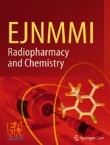Topical Collections about latest and interesting topics in EJNMMI Radiopharmacy and Chemistry are available at: https://link.springer.com/journal/41824/collections
Cu(II)-Mediated direct 18F-dehydrofluorination of phosphine oxides in high molar activity
The 18F/19F-isotope exchange method employing P(V)-centered prosthetic groups demonstrates advantages in addressing mild one-step aqueous 18F-labeling of peptides and proteins. However, the molar activity (Am) ac...



